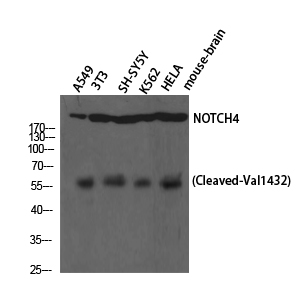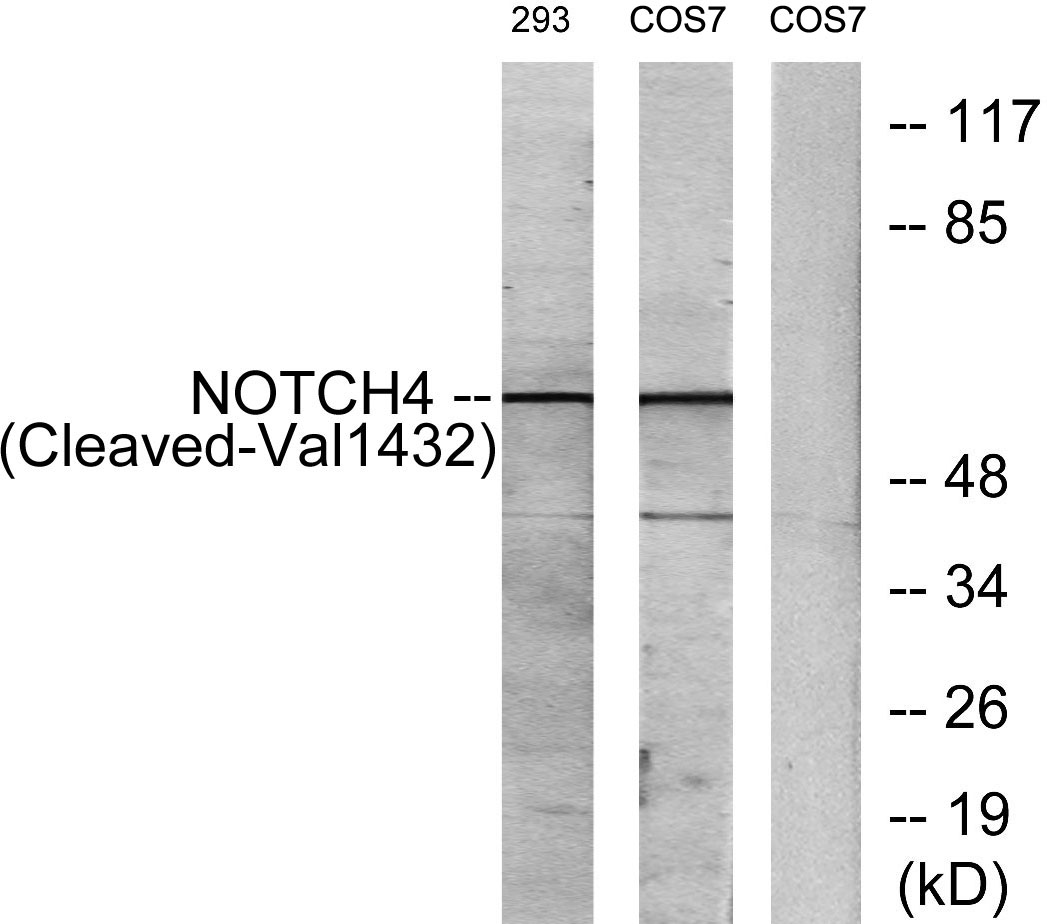Cleaved-Notch 4 (V1432) Polyclonal Antibody
- Catalog No.:YC0071
- Applications:WB;ELISA
- Reactivity:Human;Mouse;Monkey
- Target:
- Notch 4
- Fields:
- >>Endocrine resistance;>>Notch signaling pathway;>>Thyroid hormone signaling pathway;>>Human papillomavirus infection;>>Pathways in cancer;>>MicroRNAs in cancer;>>Breast cancer
- Gene Name:
- NOTCH4
- Protein Name:
- Neurogenic locus notch homolog protein 4
- Human Gene Id:
- 4855
- Human Swiss Prot No:
- Q99466
- Mouse Swiss Prot No:
- P31695
- Immunogen:
- The antiserum was produced against synthesized peptide derived from human NOTCH4. AA range:1401-1450
- Specificity:
- Cleaved-Notch 4 (V1432) Polyclonal Antibody detects endogenous levels of fragment of activated Notch 4 protein resulting from cleavage adjacent to V1432.
- Formulation:
- Liquid in PBS containing 50% glycerol, 0.5% BSA and 0.02% sodium azide.
- Source:
- Polyclonal, Rabbit,IgG
- Dilution:
- WB 1:500 - 1:2000. ELISA: 1:5000. Not yet tested in other applications.
- Purification:
- The antibody was affinity-purified from rabbit antiserum by affinity-chromatography using epitope-specific immunogen.
- Concentration:
- 1 mg/ml
- Storage Stability:
- -15°C to -25°C/1 year(Do not lower than -25°C)
- Other Name:
- NOTCH4;INT3;Neurogenic locus notch homolog protein 4;Notch 4;hNotch4
- Observed Band(KD):
- 59kD
- Background:
- notch 4(NOTCH4) Homo sapiens This gene encodes a member of the NOTCH family of proteins. Members of this Type I transmembrane protein family share structural characteristics including an extracellular domain consisting of multiple epidermal growth factor-like (EGF) repeats, and an intracellular domain consisting of multiple different domain types. Notch signaling is an evolutionarily conserved intercellular signaling pathway that regulates interactions between physically adjacent cells through binding of Notch family receptors to their cognate ligands. The encoded preproprotein is proteolytically processed in the trans-Golgi network to generate two polypeptide chains that heterodimerize to form the mature cell-surface receptor. This receptor may play a role in vascular, renal and hepatic development. Mutations in this gene may be associated with schizophrenia. Alternative splicing results in multiple transcript variants, at least one of which
- Function:
- alternative products:Experimental confirmation may be lacking for some isoforms,function:Functions as a receptor for membrane-bound ligands Jagged1, Jagged2 and Delta1 to regulate cell-fate determination. Upon ligand activation through the released notch intracellular domain (NICD) it forms a transcriptional activator complex with RBP-J kappa and activates genes of the enhancer of split locus. Affects the implementation of differentiation, proliferation and apoptotic programs. May regulate branching morphogenesis in the developing vascular system.,polymorphism:The poly-Leu region of NOTCH4 (in the signal peptide) is polymorphic and the number of Leu varies in the population (from 6 to 12).,PTM:Phosphorylated.,PTM:Synthesized in the endoplasmic reticulum as an inactive form which is proteolytically cleaved by a furin-like convertase in the trans-Golgi network before it reaches the plasma
- Subcellular Location:
- Cell membrane; Single-pass type I membrane protein.; [Notch 4 intracellular domain]: Nucleus. Following proteolytical processing NICD is translocated to the nucleus.
- Expression:
- Highly expressed in the heart, moderately in the lung and placenta and at low levels in the liver, skeletal muscle, kidney, pancreas, spleen, lymph node, thymus, bone marrow and fetal liver. No expression was seen in adult brain or peripheral blood leukocytes.
- June 19-2018
- WESTERN IMMUNOBLOTTING PROTOCOL
- June 19-2018
- IMMUNOHISTOCHEMISTRY-PARAFFIN PROTOCOL
- June 19-2018
- IMMUNOFLUORESCENCE PROTOCOL
- September 08-2020
- FLOW-CYTOMEYRT-PROTOCOL
- May 20-2022
- Cell-Based ELISA│解您多样本WB检测之困扰
- July 13-2018
- CELL-BASED-ELISA-PROTOCOL-FOR-ACETYL-PROTEIN
- July 13-2018
- CELL-BASED-ELISA-PROTOCOL-FOR-PHOSPHO-PROTEIN
- July 13-2018
- Antibody-FAQs
- Products Images

- Western Blot analysis of A549 NIH-3T3 SH-SY5Y K562 HELA cells using Cleaved-Notch 4 (V1432) Polyclonal Antibody diluted at 1:1000

- Western blot analysis of lysates from 293 and COS7 cells, treated with etoposide 25uM 1h, using NOTCH4 (Cleaved-Val1432) Antibody. The lane on the right is blocked with the synthesized peptide.



